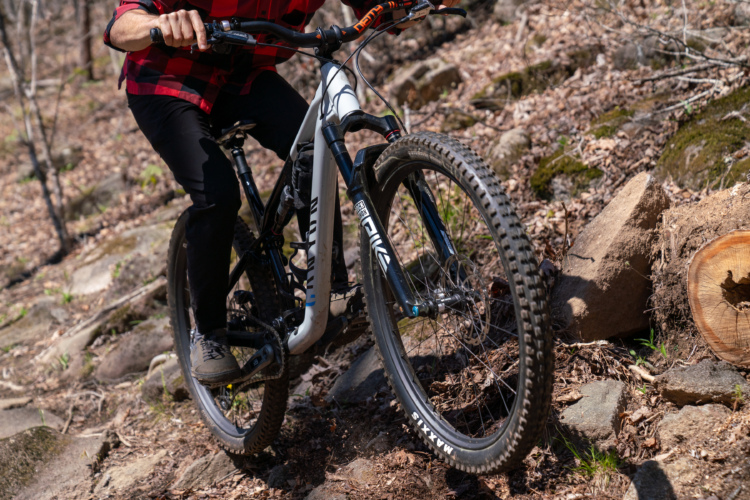If there’s one thing I can’t stand when it comes to bike racks, it’s proprietary parts. In the past, if you had a Thule base rack/crossbars you couldn’t run Yakima trays on that rack. Then thru axles came in and messed everything up, and you had to buy an adaptor to use your old trays with your new bike.

The Yakima FrontLoader tray is here to lay all of my–and your–worries to rest.
First question: what kind of crossbars/racks does the FrontLoader work with?
Answer: it works with almost every kind of crossbar imaginable, without you having to do any complicated reconfiguring. I tested a pair of FrontLoaders using factory crossbars on my Sylvansport GO camper.
Second question: what kind of bikes does the tray fit?
Answer: it fits almost every standard-sized bicycle tire imaginable. The front wheel locking device is adjustable, and has different preset increments depending on your wheel size, ranging from 20″ up to 29″. Mountain bike or road, they’ll all work in this rack.
Note: it probably won’t work with a fat bike, unless perhaps you deflate your tires first–but I haven’t tried that yet.
In Real Life
Installing these trays on my Sylvansport GO was a cinch: I just spun the jaws open, clamped it down on the factory cross bars, and spun them shut. I also purchased locks for the trays (sold separately), and with a full set of locks installed the tray is locked to the rack and the bike is locked to the tray via a cable.


Installing the bike in the tray is relatively simple, once you get the hang of it:
- Pull the front jaw forward so that the closure is in the open position.
- Flip down the red levers on the front jaw clamp, slide it into the correct position for your wheel size (as per the markings on the side of the jaw), and then click the red levers back up into place. (You only have to do this once unless you swap out bikes with different size wheels.)
- Spin the big red knob counter clockwise as far as possible (or as far as necessary, once you get the feel for it) to open the jaws up as wide as they can go.
- Set your bike on the tray, and put the front wheel on the solid-looking plastic piece.
- Pull the front wheel forward into the front arm as much as possible, and push the front arm up on the wheel as much as possible. This will allow the rear clamp to come up as far as possible, making a firm closure.
- Ensuring that the bike stays firmly forward in the jaw, spin down the red knob, and tighten it as much as possible. Spinning the red knob down brings the rear clamp up, which creates the final closure and pressure on the wheel.
- Finally, lightly strap in the rear wheel to keep it from coming off the rack. You may need to slide the strap closure up or down the tray to make it line up with the wheel.
And you’re done!


While it took a few words to describe that process, in real life it’s painless, fast, and oh-so-easy. Seriously, the days of removing your front wheel and messing around with a quick release clamp on your fork drop outs are long gone, and I’m so thankful! Not only is it way easier and faster, but you don’t have to worry about backing over your wheel or having enough room in the vehicle for your wheel.
Since the trays were mounted on my camper, I did have some concern about the security of the bicycles when driving down rough mountain roads to reach the campground. Since the camper would bounce and jump over rocks and ruts, it would cause the bikes to sway a bit, seemingly precariously. However, they always stayed put, even after pulling the camper down roads that it probably shouldn’t have traveled down. 🙂

Once you do reach pavement again, it’s a good idea to get out and check that red dial. After a lot of bouncing down backroads that dial can loosen up a bit, so just throw a few more twists in it to tighten it back down. Over the course of my test I found this to be less of an issue if I made doubly sure to pull the wheel tight into the front of the rack during the initial bike install (as mentioned above), but it’s not a bad idea to double check the tension on the red knob now and again.
You have to do it less frequently, but it’s a good idea to check the tension of the tray on the crossbars every now and then as well. During my initial tray install I found that I didn’t tighten them down quite enough, so the trays were sliding around a bit on the crossbars. They would never have come off, but for added security I’ve cranked they down as hard as possible, and have had no further issues with them.

Bottom Line
The FrontLoader is a genius tray design that removes all of the headaches that I’ve previously associated with bike transport trays. Forget about compatibility issues. Forget about removing wheels. Forget about making sure it fits your bike. The FrontLoader just works, and Yakima’s quality construction ensures that it’ll just keep working for years to come!
MSRP: $179 per tray
Thanks to Yakima for providing the FrontLoader for review









